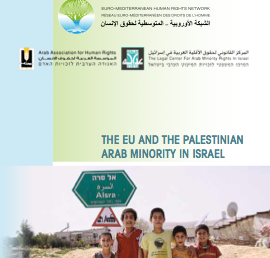On the 40th anniversary of Land Day: Adalah releases new report on Israel’s discriminatory land and housing policies in 2015
(Haifa, Israel) To mark the 40th anniversary of Land Day, on 30 March 2016, Adalah issued its annual Land Day report, monitoring Israel’s land marketing and allocation for Palestinian citizens of Israel. The report compiles and analyzes official government statistics of the Israel Land Authority (ILA) and the Ministry of Construction and Housing and indicates the furtherance and continuation of discriminatory land policies as well as a worsening of the land and housing crisis in Palestinian towns and villages in Israel.
According to the report prepared by Adalah Attorney Mohammed Bassam, "the majority of marketing of land, including the publication of tenders (bids), as well as efforts to reduce housing prices, are allocated to Israeli Jewish or mixed Arab-Jewish communities, while almost no efforts is being invested in solving the housing shortage in the 136 Arab communities, in which 91% of Palestinian citizens of Israel reside."
According to the data, only 4.6% of the housing tenders published by the ILA in 2015 were dedicated to Arab communities in Israel, although the population comprises 20% of the citizens of the state. The ILA published tenders for the construction of 38,095 housing units in Israeli Jewish and mixed communities, as opposed to only 1,835 housing units in Arab towns and villages. Moreover, in 2015, the ILA listed 27,539 housing units in Israeli Jewish and mixed communities within the “Occupant’s Price” framework for lowering housing prices, in contrast to only 729 such units in Arab towns (2.5%). The report also shows that Arab towns received just 2 out of 20 tenders for the establishment of industrial zones, and 5 of 42 tenders to establish commercial zones. Of the 37 tenders for commercial areas in Israeli Jewish communities, 11 were published in illegal settlements in the West Bank.
The report also details discrimination in the government’s designation of national priority areas (NPAs), where the state subsidizes development costs for new housing in these communities by 20% to 70%. Of the 558 rural towns classified as NPAs, only 30 are Arab villages. And of the 363 villages that actually received their benefits, only 3 were Arab villages (less than 1%).
As Adalah argues in its report, the housing shortage in Arab communities in Israel is not the result of specific failures or unintentional neglect on the part of state authorities. Rather it is instead the product of a systematic and deliberate policy since 1948 that has viewed Palestinian citizens as enemies and aliens. Accordingly, the solutions to the housing crisis for the Palestinian community in Israel must contend with the ongoing and historic injustice against the Palestinian people in a deep and comprehensive manner.
Read the full report in: English | Arabic | Hebrew
For more details and to coordinate interviews:
Majd Kayyal, Media Coordinator: 050-638-6646
















